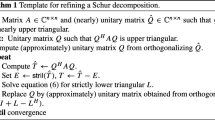Abstract
The problem of deleting a row from a Q–R factorization (called downdating) using Gram–Schmidt orthogonalization is intimately connected to using classical iterative methods to solve a least squares problem with the orthogonal factor as the coefficient matrix. Past approaches to downdating have focused upon accurate computation of the residual of that least squares problem, then finding a unit vector in the direction of the residual that becomes a new column for the orthogonal factor. It is also important to compute the solution vector of the related least squares problem accurately, as that vector must be used in the downdating process to maintain good backward error in the new factorization. Using this observation, new algorithms are proposed.
One of the new algorithms proposed is a modification of one due to Yoo and Park [BIT, 36:161–181, 1996]. That algorithm is shown to be a Gram–Schmidt procedure.
Also presented are new results that bound the loss of orthogonality after downdating. An error analysis shows that the proposed algorithms’ behavior in floating point arithmetic is close to their behavior in exact arithmetic. Experiments show that the changes proposed in this paper can have a dramatic impact upon the accuracy of the downdated Q–R decomposition.
Similar content being viewed by others
References
J. L. Barlow, A. Smoktunowicz, and H. Erbay, Improved Gram–Schmidt type downdating methods, Technical report, Department of Computer Science and Engineering, The Pennsylvania State University, University Park, PA, June 2004. http://www.cse.psu.edu/∼barlow/GS_downdate.ps.
Å. Björck, Numerical Methods for Least Squares Problems, SIAM Publications, Philadelphia, PA, 1996.
Å. Björck, Iterative refinement of linear least squares solutions I, BIT, 7 (1967), pp. 257–278.
Å. Björck, Solving linear least squares problems by Gram–Schmidt orthogonalization, BIT, 7 (1967), pp. 1–21.
Å. Björck, Iterative refinement of linear least squares solutions II, BIT, 8 (1968), pp. 8–30.
Å. Björck, Numerics of Gram–Schmidt orthogonalization, Linear Algebra Appl., 197/198 (1994), pp. 297–316.
Å. Björck and C. C. Paige, Loss and recapture of orthogonality in the modified Gram–Schmidt algorithm, SIAM J. Matrix Anal. Appl., 13 (1992), pp. 176–190.
J. W. Daniel, W. B. Gragg, L. Kaufman, and G. W. Stewart, Reorthogonalization and stable algorithms for updating the Gram–Schmidt QR factorization, Math. Comp., 30(136) (1976), pp. 772–795.
J. J. Dongarra, J. J. DuCroz, S. J. Hammarling, and R. J. Hansen, An extended set of Fortran basic linear algebra subroutines, ACM Trans. Math. Softw., 14 (1988), pp. 1–17.
H. Erbay, J. L. Barlow, and Z. Zhang, A modified Gram–Schmidt–based downdating technique for ULV decompostions with applications to recursive TLS problems, Comput. Stat. Data Anal., 41(1) (2003), pp. 195–211.
G. H. Golub and C. F. Van Loan, Matrix Computations, Third Edition, The Johns Hopkins Press, Baltimore, MD, 1996.
L. A. Hageman and D. M. Young, Applied Iterative Methods, Academic Press, New York, 1981.
W. Hoffmann, Iterative algorithms for Gram–Schmidt orthogonalization, Computing, 41 (1989), pp. 353–367.
A. Kiełbasiński, Analiza numeryczna algorytmu ortogonalizacji Grama–Schmidta (in Polish), Roczniki Polskiego Towarzystwa Matematycznego, Seria III: Matematyka Stosowana, II (1974), pp. 15–35.
J. Langou, Solving linear systems with multiple right-hand sides, PhD thesis, University of Toulouse, Toulouse, France, 2003.
P. Läuchli, Jordan-Elimination und Ausgleichung nach kleinsten Quadraten, Numer. Math., 3 (1961), pp. 226–240.
C. L. Lawson, R. J. Hanson, D. R. Kincaid, and F. T. Krogh, Basic linear algebra subprogams for FORTRAN usage, ACM Trans. Math. Softw., 5 (1979), pp. 308–325.
J. M. Ortega, Numerical Analysis: A Second Course, SIAM Publications, Philadelphia, PA, 1990.
B. N. Parlett, The Symmetric Eigenvalue Problem, SIAM Publications, Philadelphia, PA, 1998. Republication of 1980 book.
A. Ruhe, Numerical aspects of Gram–Schmidt orthogonalization of vectors, Linear Algebra Appl., 52/53 (1983), pp. 591–601.
R. S. Varga, Matrix Iterative Analysis, Prentice-Hall, Englewood Cliffs, NJ, 1962.
J. Weissinger, Verallgemeinerungen des Seidelschen Iterationsverfahrens (in German), Z. Angew. Math. Mech., 33 (1953), pp. 155–163.
K. Yoo and H. Park, Accurate downdating of a modified Gram–Schmidt QR decomposition, BIT, 36 (1996), pp. 166–181.
Author information
Authors and Affiliations
Corresponding authors
Additional information
AMS subject classification (2000)
65F20, 65F25
Rights and permissions
About this article
Cite this article
Barlow, J., Smoktunowicz, A. & Erbay, H. Improved Gram–Schmidt Type Downdating Methods. Bit Numer Math 45, 259–285 (2005). https://doi.org/10.1007/s10543-005-0015-2
Issue Date:
DOI: https://doi.org/10.1007/s10543-005-0015-2




